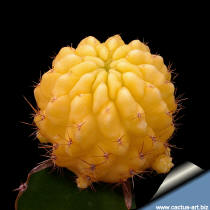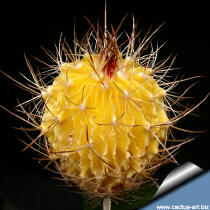|

A
Lobivia pentlandii (forma albina) grafted on a green
Hylocereus undatus stock.

Echinofossulocactus sp.
"albinos"
|
Every once in a
while a plant exhibit albinism. We can find albino seedlings,
albino stems, albinos leaves etc. in many different plant
species. While floral albinism is common in some species, less
so in others, and commercially desirable in many cases.
Albino seedlings probably result from a genetic mutation. While
albino stems or leaves are thought to develop from mutation in a
single cell or in a group of cells, because the rest of the
plant from which the albino stem grows can be normal.
As in animals, albinism in plants is caused by lack of pigment.
However, Unless the plant is parasitic or saprophytic, leaf and
stem albinism is generally a fatal trait (can't produce its own
food and it's not getting it from anything else). Without
chlorophyll, the albino plant has no way to manufacture the food
needed for survival and growth to maturity.
Albino seedlings usually live only about a week, but albino
stems tend toward a bit more longevity because they can draw
food from the parent plant.
If the albino plant is growing from the stem of a normal plant,
there may be transitional features at the juncture. For example
a stem may show mixed albino and normal characteristics, beyond
it various albino shoots grew.
Not all
mutations or unusual gene combinations are harmful. In fact, by
watching for favorable abnormalities it has been possible to
develop new varieties of ornamental plants. But this plants
connot survive on their own roots and necessitate to be grafted
on a normal green plant that provide food. Some of this albinos
plant are indeed very popular and sought after by plant
collectors.
|